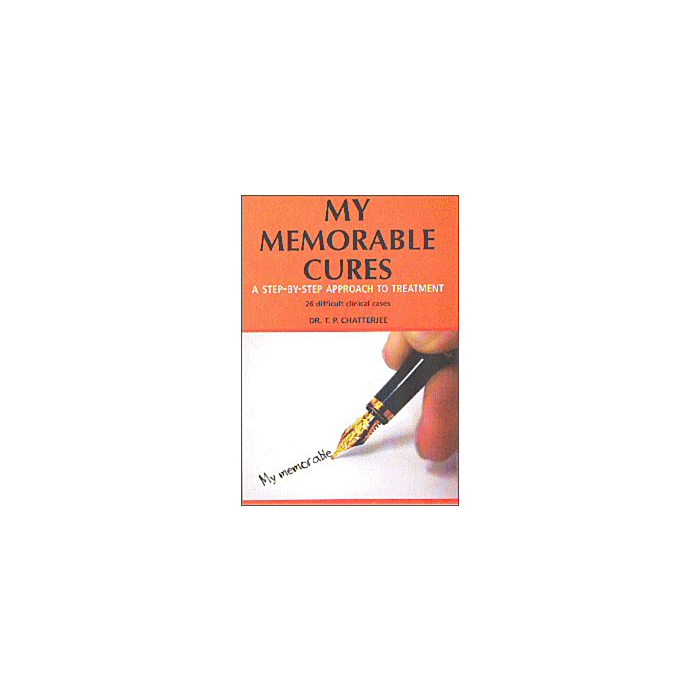My Memorable Cures
Delen op sociale media
| ISBN | 9788170211600 |
|---|---|
| Auteur | T.P. Chatterjee |
| Type | Paperback |
| Taal | English |
| Publicatiedatum | 2001-01-01 |
| Pagina's | 104 |
| Uitgever | B. Jain |
| Recensie | This book review is reprinted with the permission of the International Foundation for Homeopathy Well-defined case histories provide a useful treasury for homeopaths. This little book of 26 cases belongs by its quality in that treasury. Dr. Chatterjee is described in the introduction by Dr. H. L. Chitkara, an editor of The Homoeopathic Heritage, as one in the 80th year of his life, who took MA in economics, an MSc in mathematics, completed training for the LLB and served in the Central Secretariat in New Delhi. He took up homeopathy after he witnessed the homeopathic cure of two young cousins from severe bacillary dysentery after the exhaustion of allopathic treatment. He went on to become a licensed practitioner and has published Fundamentals of Homeopathy and Valuable Hints for Practice and Highlight of Homeo-Practice. Credentials, however great or small, are outweighed by the internal evidence of the work presented, which shows keen homeopathic insight. Among the cases presented are examples of osteoarthritis, chronic colds and sore throat, bronchitis, ovarian cyst, cerebrospi nal discord, and reliance on prescription antidepressants. A typical case will detail the patient's background, appearance, medical history and that of the family where available, the possible etiology and allopathic diagnoses, including tests if taken, and the symptoms presenting. The miasmatic background of the patient also is specified. The first prescription and the follow-ups are carefully dated, with dose and potency detailed. We find both examples of the single dose, and combined doses (Sulphur 200 and Lycopodium 30 given at the same time, for example), serial potencies (Hepar Sulphur 30,200, and 1M to be taken concurrently), as well as the use of tinctures, biochemic remedies and vitamins concurrent with higher potencies. The use of nosodes and small remedies, along with the major polychrests, ate well illustrated. And, perhaps especially for the new student, a fine feature of the case presentation is the concluding paragraph which gives the rationale for the remedies used. As Dr. Chitkara remarks, "such books giving authentic and clear-cut details of case records are very rare these days. The reason is not a lack or scarcity of such material in the hands of the most successful homeopathic practitioners in India or abroad, but that very few practitioners take the trouble of recording the details of cases during their otherwise busy and successful practice." But where such practitioners make the time, as here, the result is a work that may serve the homeopathic community for many generations. RESONANCE MARCH-APRIL 1993 |
Recensie
This book review is reprinted with the permission of the International Foundation for Homeopathy
reviewed by Daniel Papish
Well-defined case histories provide a useful treasury for homeopaths. This little book of 26 cases belongs by its quality in that treasury. Dr. Chatterjee is described in the introduction by Dr. H. L. Chitkara, an editor of The Homoeopathic Heritage, as one in the 80th year of his life, who took MA in economics, an MSc in mathematics, completed training for the LLB and served in the Central Secretariat in New Delhi. He took up homeopathy after he witnessed the homeopathic cure of two young cousins from severe bacillary dysentery after the exhaustion of allopathic treatment. He went on to become a licensed practitioner and has published Fundamentals of Homeopathy and Valuable Hints for Practice and Highlight of Homeo-Practice. Credentials, however great or small, are outweighed by the internal evidence of the work presented, which shows keen homeopathic insight.
Among the cases presented are examples of osteoarthritis, chronic colds and sore throat, bronchitis, ovarian cyst, cerebrospi nal discord, and reliance on prescription antidepressants. A typical case will detail the patient's background, appearance, medical history and that of the family where available, the possible etiology and allopathic diagnoses, including tests if taken, and the symptoms presenting. The miasmatic background of the patient also is specified. The first prescription and the follow-ups are carefully dated, with dose and potency detailed.
We find both examples of the single dose, and combined doses (Sulphur 200 and Lycopodium 30 given at the same time, for example), serial potencies (Hepar Sulphur 30,200, and 1M to be taken concurrently), as well as the use of tinctures, biochemic remedies and vitamins concurrent with higher potencies. The use of nosodes and small remedies, along with the major polychrests, ate well illustrated. And, perhaps especially for the new student, a fine feature of the case presentation is the concluding paragraph which gives the rationale for the remedies used.
As Dr. Chitkara remarks, "such books giving authentic and clear-cut details of case records are very rare these days. The reason is not a lack or scarcity of such material in the hands of the most successful homeopathic practitioners in India or abroad, but that very few practitioners take the trouble of recording the details of cases during their otherwise busy and successful practice." But where such practitioners make the time, as here, the result is a work that may serve the homeopathic community for many generations.
RESONANCE MARCH-APRIL 1993

